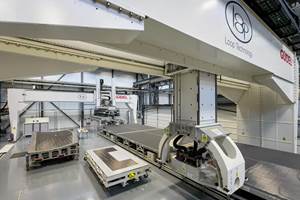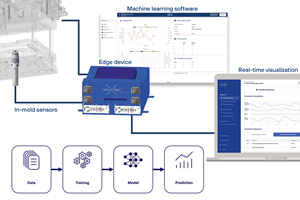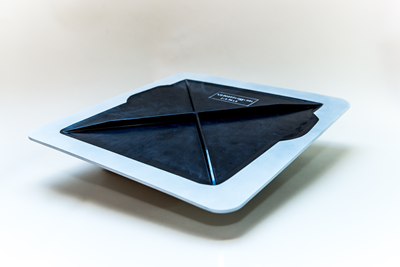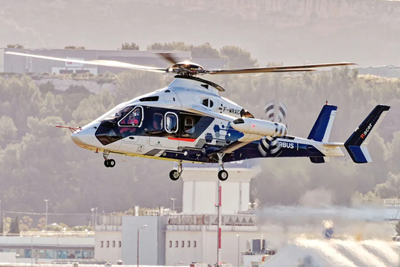Leonardo unveils Proteus uncrewed rotorcraft demonstrator design
In the development of this fast-moving program, Leonardo is using a digital twin for synthetic development, more than 40 composite components and the use of AI in its control software.
Leonardo (Rome, Italy), the Royal Navy (Portsmouth, U.K.) and the UK Ministry of Defence’s Defence Equipment and Support (DE&S) Future Capability Innovation (FCI) team have unveiled the design of the Proteus technology demonstrator aircraft. The circa 3-tonne uncrewed rotorcraft, manufactured with composites, will be used to demonstrate advances in autonomy and payload modularity and interchangeability, while developing novel rotorcraft technologies including design and manufacturing techniques.
Proteus’ development supports the Royal Navy’s Maritime Aviation Transformation (MATx) strategy, which covers the evolution of maritime aviation out to 2040. This includes building mass at sea and supporting future anti-submarine warfare missions.
Ultimately, the closer collaboration between Leonardo, DE&S and the Royal Navy has enabled the €71 million (£60 million) project, initially contracted in 2022, to move forward at-pace, with the demonstrator on-track to fly for the first time in mid-2025.
The demonstrator’s design — as shown in the image above — reveals that it has drawn on components from throughout Leonardo's helicopter portfolio in order to reduce costs and accelerate aircraft development. Leonardo has also drawn on knowledge and experience from across its existing uncrewed air system (UAS) program. Partners believe that this design will demonstrate the viability of large UAS in the maritime environment and will function as a test bed for the development and demonstration of autonomous capability. This includes flight control laws and algorithms for large, autonomous vertical takeoff and landing (VTOL) aircraft.
Leonardo is also experimenting with the application of new digital manufacturing technologies in rotorcraft production.
Notably, the Proteus design features a modular payload bay. This is designed to enable flexibility in mission roles, including the ability to trade fuel for mission payload. The ability to plug in specific payloads for different missions aims to give commanders in the field a wide range of options from a single type of aircraft. This is both operationally useful and delivers value by avoiding the need to buy and maintain multiple different fleets of aircraft.
Leonardo’s site in Yeovil is said to maintain an aggressive autonomy development roadmap, which covers the capabilities required to conduct autonomous flight and deliver mission capability. In practice, this means maturing and testing a range of transformative technologies and techniques, for the design and manufacture of rotorcraft as well as on-board the aircraft itself.
For instance, Leonardo has created a digital twin of the Proteus technology demonstrator to aid in development. Using a digital twin, AI and machine learning algorithms in a synthetic environment enables Leonardo to test, modify and prove capability without the need for live aircraft trials, thereby reducing costs and significantly accelerating development when compared to traditional rotorcraft program.
Leonardo is also experimenting with the application of new digital manufacturing technologies in rotorcraft production, including additive layer manufacturing (3D printing) and the use of cost-effective, low-temperature-cure composite materials, which require fewer manufacturing stages in the production of parts.
Once proven, these technologies will be employed more extensively to deliver agility through spiral development techniques, reduce through-life costs in comparison to conventional crewed aircraft, and improve manufacturing resilience and sustainability throughout Leonardo’s supply chain.
In addition to innovating in technologies, Leonardo is also using the Proteus program to transform its approach to collaboration with customers and end users. The company is drawing on an “agile” methodology that breaks the project into phases and emphasizes continuous collaboration and improvement.
Related Content
IMDEA introduces digital twin for real-time analysis of composite materials production
Newly designed digital twin by IMDEA and Technical University of Madrid researchers enables manufacturers to see inside composite materials as they are being produced, facilitating early detection of faults.
Read MoreUltra high-rate composite deposition system trials to surpass layup targets
The NCC, alongside partners Loop Technology, Coriolis and Güdel, are on track to deliver dry fiber deposition rates exceeding 350 kilograms/hour, seven times more than standard aerospace rates.
Read MoreNext-gen composites manufacturing: Combining material, machine and mold cavity data with analytics
Using a sensor, an edge device and machine learning software, sensXPERT sees into processes and is improving quality and cutting scrap, cycle time and energy use for composites customers like ZF and Carbon Revolution.
Read MoreSAM XL demonstrates closed-loop digital methodologies via full-size aerocomposite parts development
PeneloPe Project’s modular, zero-defect manufacturing deliverables are being highlighted in an upcoming video that demonstrates the resulting aerospace pilot line’s feasibility.
Read MoreRead Next
Recycled thermoplastic composite rotorcraft access panel takes flight
Designed as part of the TPC-Cycle program, the flight-tested panel demonstrates a lighter, cost-effective, sustainable thermoplastic composite application.
Read MoreLeonardo Aerostructures can no longer wait on Boeing solution, explores carve-out, alliances
After continued reductions (-36-41%) in 787 production, this key supply chain link for fuselage sections and other composite parts looks at restructuring options for the Grottaglie facility and Aerostructures Division.
Read MoreAirbus Helicopters RACER demonstrator performs first flight
Rotorcraft architecture featuring a highly composites-intensive design transitions into 2-year flight campaign to demonstrate its high-speed capabilities.
Read More


























